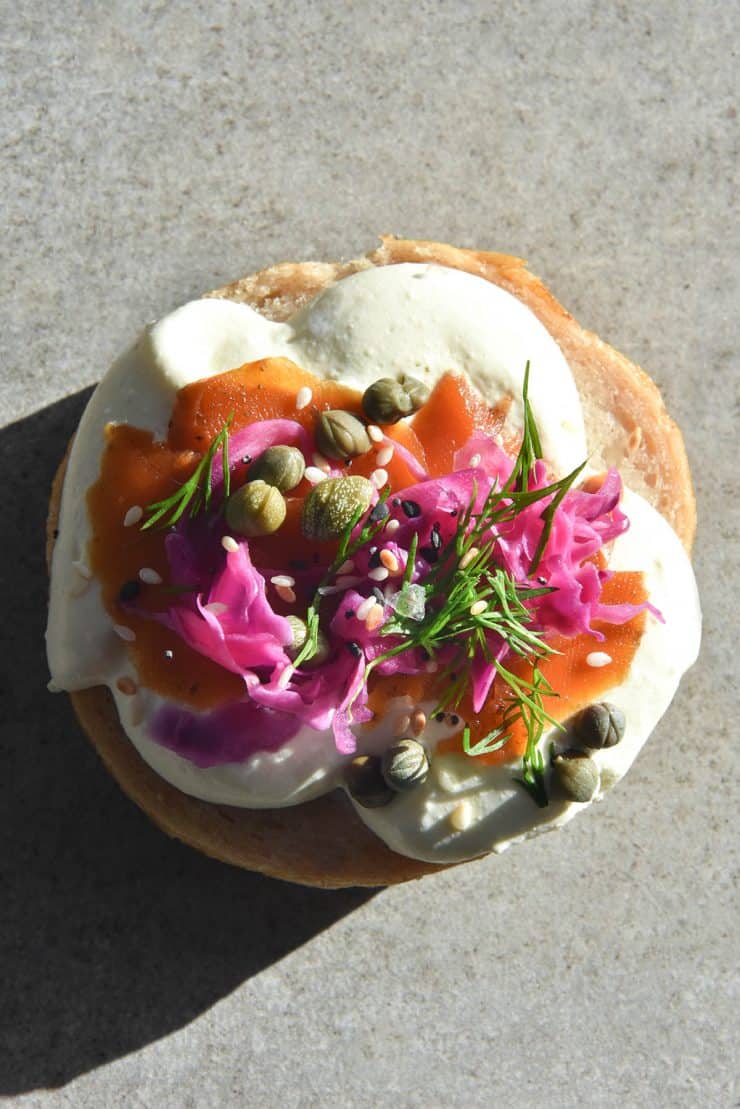
I had always wanted to include a recipe for gluten free bagels in my cookbook Intolerance Friendly Kitchen. They are a staple I have always wanted to conquer, but I couldn’t get achieve that chewy inside and glossy outside in time. I’m pleased to say I have finally conquered the art, and these gluten free bagels tick all the boxes! They’re chewy, fluffy yet dense, glossy and delicious. Better yet, they don’t necessarily need any rising time, so they’re quicker to make, too!
Gluten free bagels without xanthan gum
These gluten free bagels are nut free, egg free without the egg wash and FODMAP friendly with the appropriate toppings. They are made without xanthan gum and are naturally dairy free. These bagels are also naturally gluten free vegan bagels with a plant based egg wash for browning.
The dough is made with a simple mix of rice flour, sorghum flour and tapioca flour. It uses psyllium husk powder for binding. This quick and easy dough has lots of proofing options. You can make these bagels immediately, let them proof once shaped, and even proof the dough overnight.
One last hard sell? These bagels freeze exceptionally, making them great for a freezer stash on those days when making gluten free bread is out of the question.
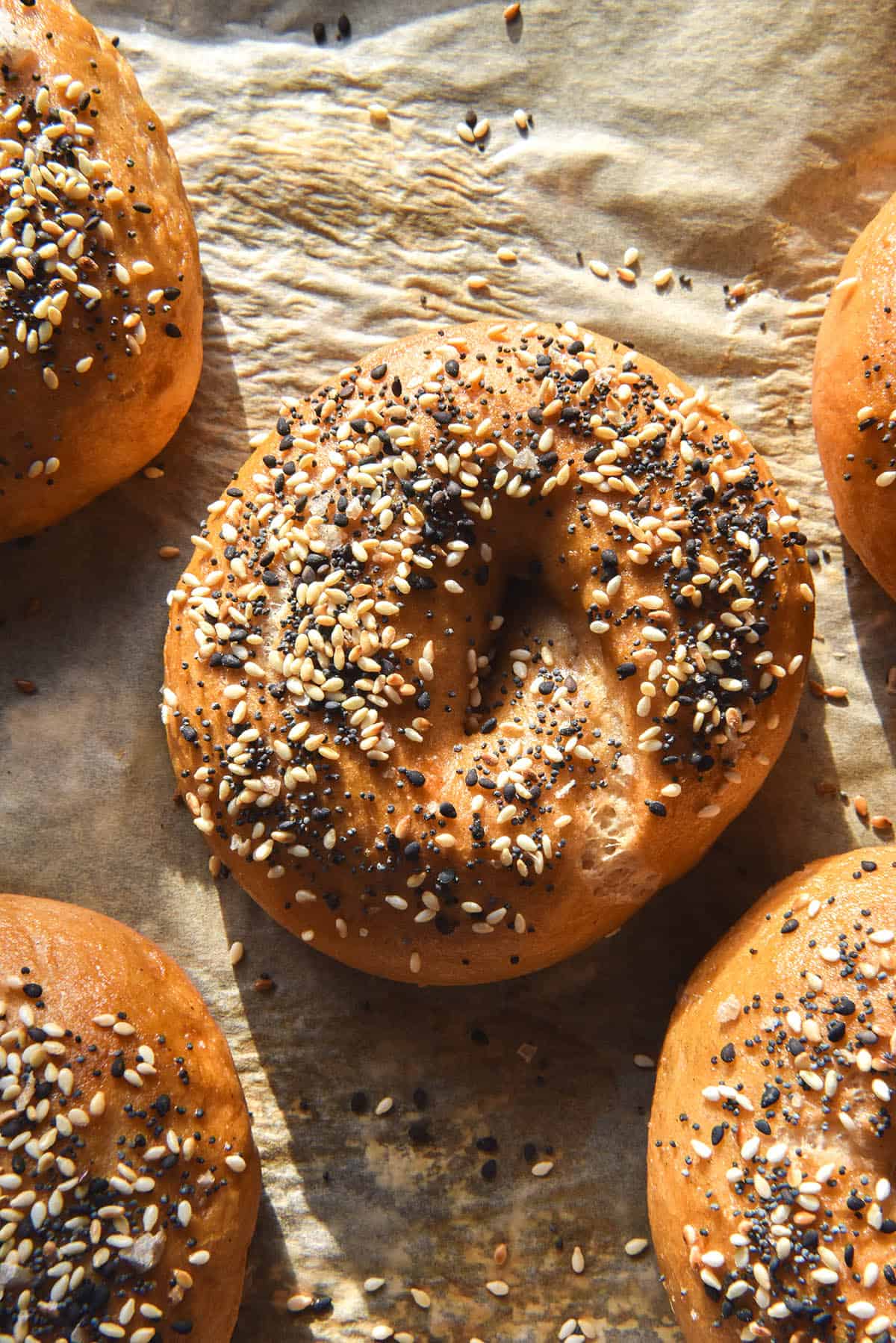
What is a scald and how does it work for these gluten free bagels?
Scalding flour (in this case) is a deceptively simple process of pouring boiling water over flour. In this case, I find that it’s best to scald only wholegrain flours. Starches can ball up (think of tapioca pearls) and create an uneven result. They also have elasticity as it is, so they don’t need more.
Why scald? Scalding flour gelatinises the starches in the flour. It gives them extra binding capabilities and elasticity. Basically, it makes gluten free flour perform more like gluten containing flour. If you have made the gluten and gum free free tortillas or dumpling wrappers from Intolerance Friendly Kitchen, you will have seen how magical a scald can be.
Scalding also allows the flour being scalded to absorb significantly more water than regular flour. This means we can achieve a moist end product without having a sloppy and hard to manage dough. This is particularly important when said dough needs to be shaped, as in the case of bagels.
Scalding also seems to make the dough rise a lot quicker than regular yeasted dough. This is great because the recipe relies on oven spring and a short stint in the fridge, rather than a dedicated rising time.
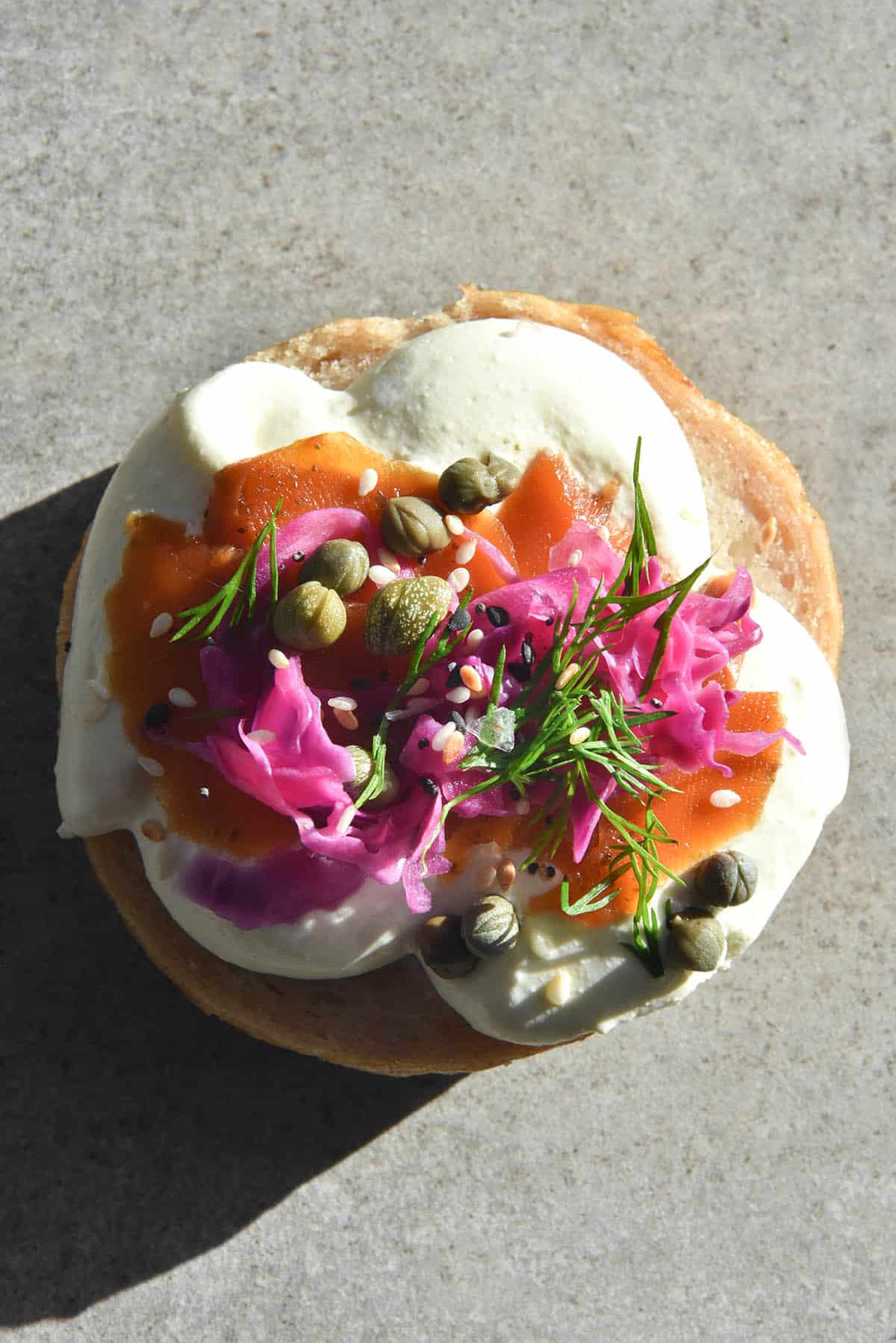
Boiling your gluten free bagels
All New Yorkers will tell you that bagels need to be boiled. So, we’re boiling the bagels. I love doing this because it creates a shiny, glossy bagel. It is also a form of scald – gelatinising the flours on the outside of the bagel. This helps in appearance, browning and chewiness. There is no option to not boil these bagels – it’s not tricky and we don’t have a rising time, so no excuses.
The boiling time for bagels depends on a variety of factors. Of note- boiling a bagel ‘sets’ the starches and kills off some of the yeast. If you boil your bagels for 5 minutes, they likely won’t grow in the oven. So ideally, we want to gelatinise the outside without setting it too much or killing off all the yeast. You can play around with boiling time depending on how much you want the bagels to grow, how many you add to the water at once, what size you made them, etc. The best sort of experimentation.
You can boil the bagels in well salted water, or add in some additional flavour at this point. I tried Molasses and didn’t notice much difference. One hot tip I discovered was to add a touch of baking soda to the boiling water. Baking soda helps things to brown in the oven (known as the Maillard reaction) so this will help your bagels take on a bit more colour, if you’re into that.
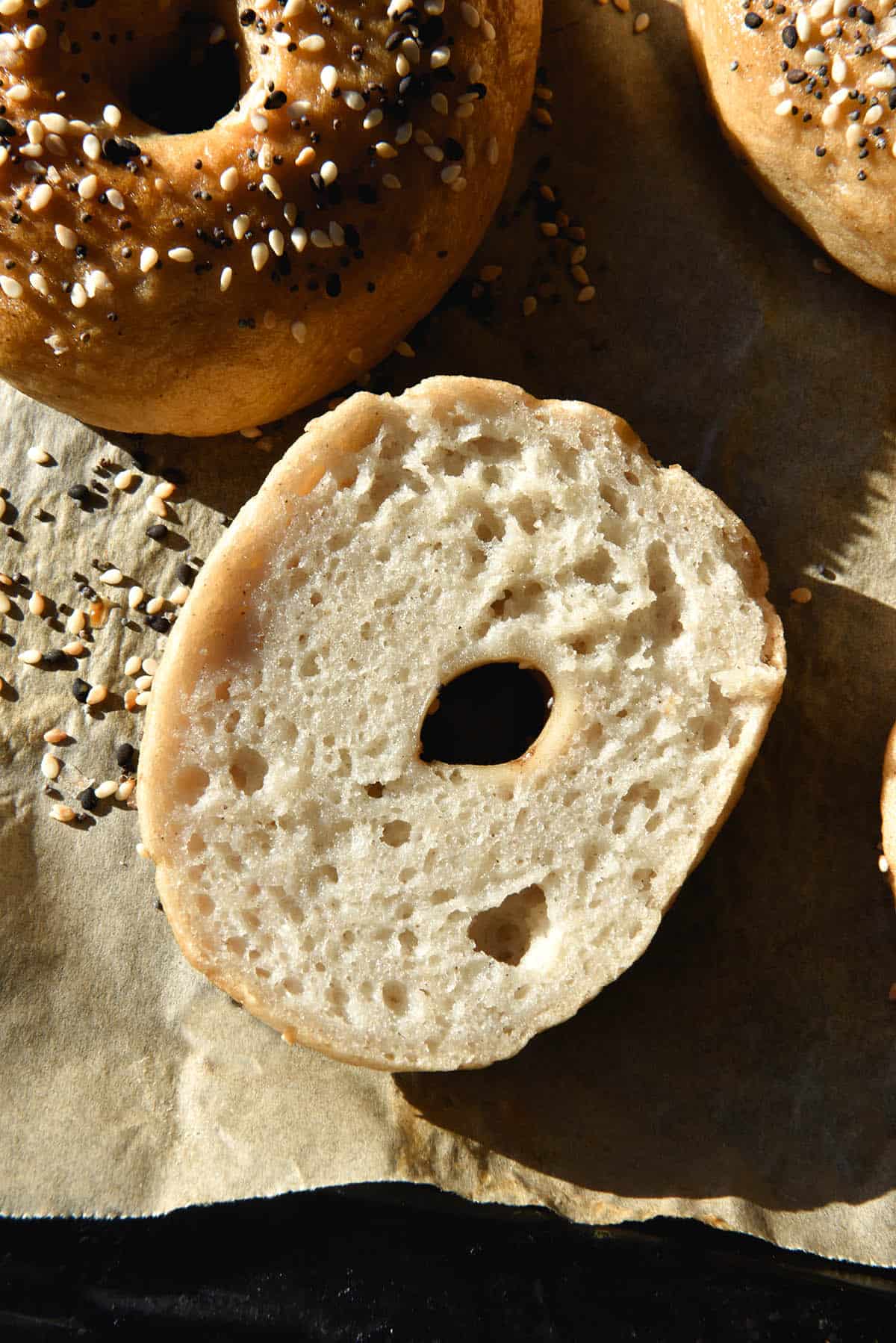
Ingredient notes for gluten free bagels
- The scald is not optional in this recipe.
- I have not tested any flour combinations other than the one in the recipe card. If you’d like to do some experimenting, you are welcome to!
- There is always confusion around yeast (I’m still confused). In Australia, the most common form of yeast is instant dried yeast, which is sold in 7.5g sachets. It would seem that yeast can be sold in cannisters elsewhere (and here, too). Simply use 7.5g of yeast. If you are using sachets and they are 7g and opposed to 7.5g, just use one. .5g less yeast will not ruin your bagels.
- The sugar is added for flavour, browning and as food for the yeast. It’s a modest amount.
- As noted above, you can add any flavour into the bagel dough that you fancy.
- I use psyllium husk powder, not the whole flakes, for this recipe. Please use powder for best results – I grind my own from the flakes. The powder is more absorbent than the flakes, so it is not a direct substitution.
- Any plain flavoured oil works here. The oil provides moisture and browning, extends the shelf life, and makes for a chewier crumb.
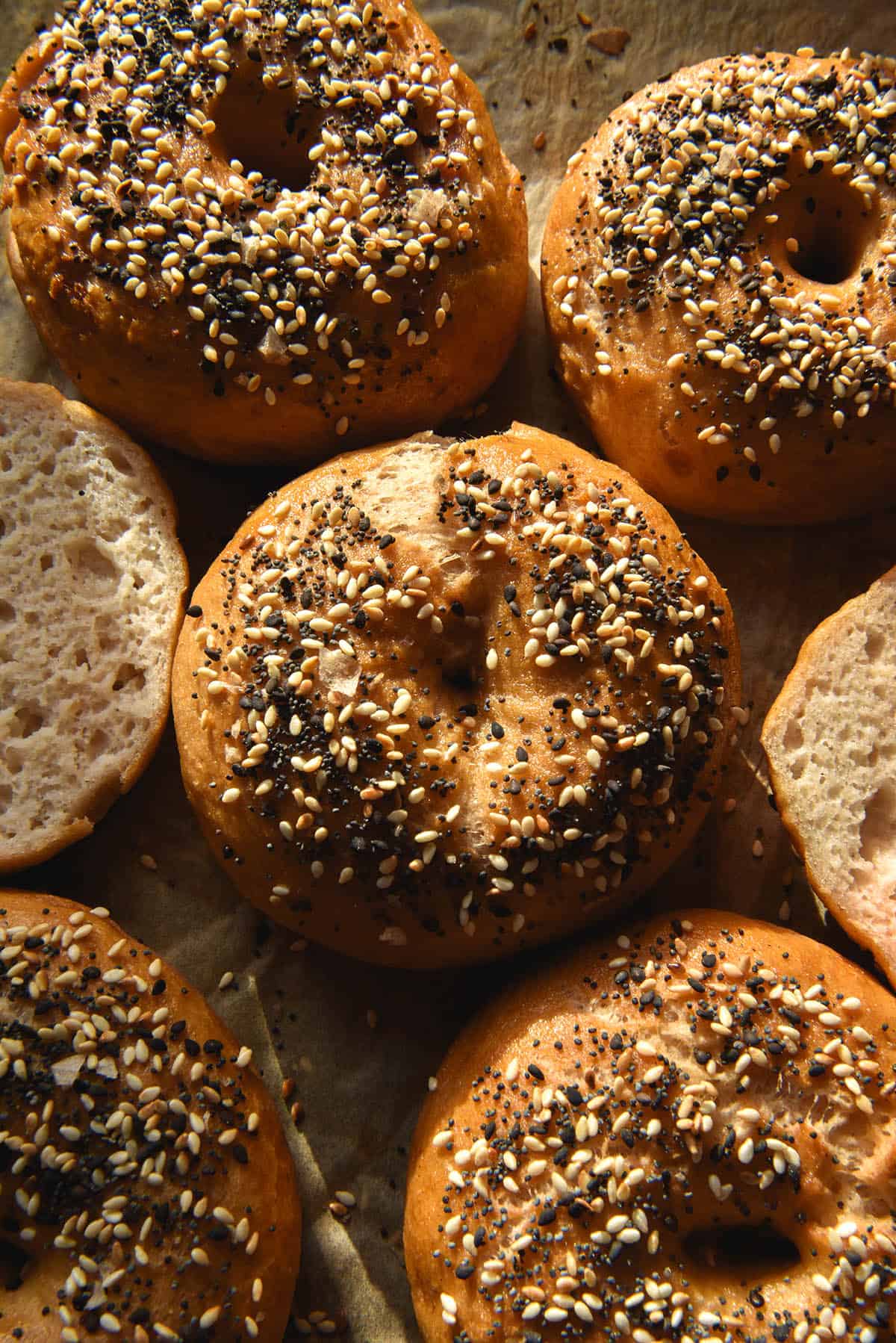
A note on xanthan gum
I have tested a batch of bagels with 1/4 teaspoon of xanthan. I found it added a fluffiness to the dough that was quite pleasant. It also added a small hint of extra chewiness, which is what we’re after in a bagel. Whether it was luck or the xanthan gum, I found the dough to be wetter than the non-xanthan containing dough. I needed to use a scant amount of flour to roll out the bagels, whereas I didn’t need that with the other versions.
This recipe for gluten free bagels has been designed to be xanthan gum free. There is absolutely no need to add it if you don’t want to. For people who have no particular issues with xanthan gum, it’s a handy ingredient in this case.
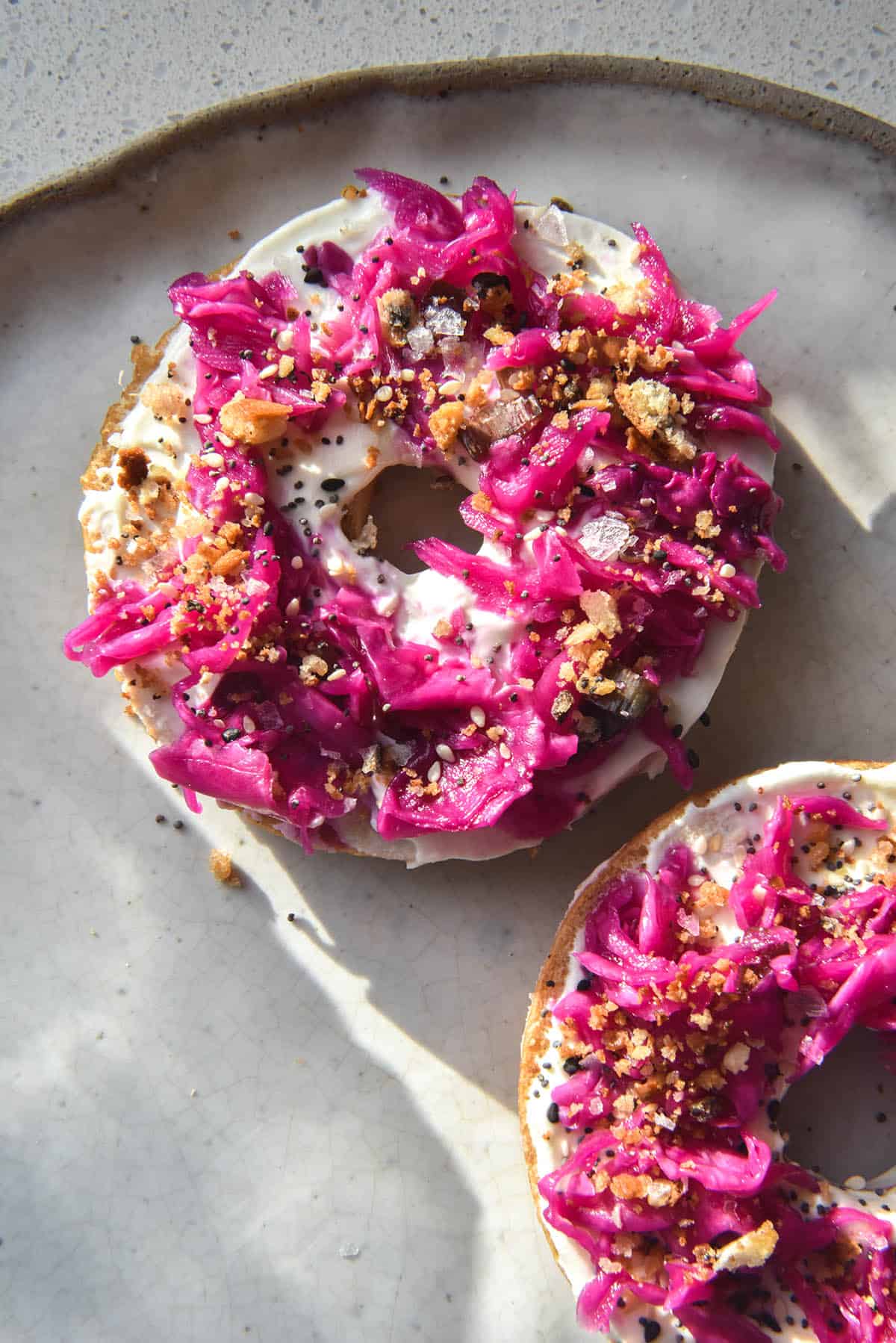
Important notes for your gluten free bagels
Hydration is highly dependent on the flours you’re using. As we all know, this varies greatly from brand to brand, country to country. If your dough is excessively dry, add more water! Your flours are very likely different to mine. If your dough is getting to the stage of becoming a batter, stop adding water! You need to use your intuition in baking.
Ensuring your yeast is alive and fresh is critical. I don’t bloom my yeast in this recipe – it’s quicker and easier. That said, I develop recipes professionally, so I don’t have old sachets of yeast sitting at the back of my cupboard. If your yeast is a little dusty or you like the security of blooming yeast, use roughly 1/4 cup (60ml) of warm water and a teaspoon of sugar to do so. Subtract this liquid amount out of the quantity added to the dough. Add the bloomed yeast liquid (scooping out all the foamy bits) as you add the liquid.
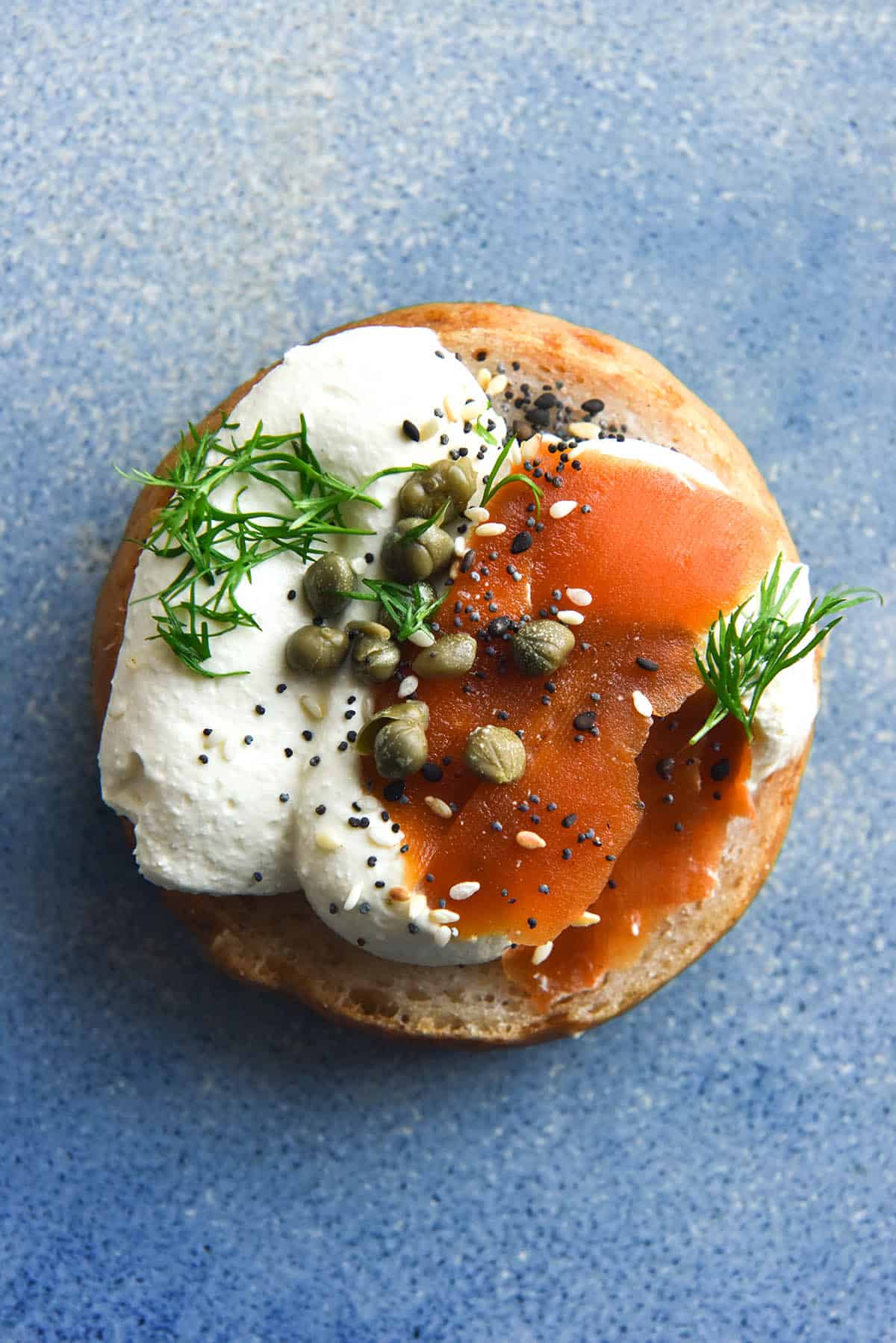
Proofing options for your gluten free bagels
There are a million and one proofing options for these bagels, depending on how light and airy you prefer them and how much time you have. The scald creates an easy food source for the yeast, so the dough proofs nicely every which way.
- Simply allow the dough to proof for 30 minutes in the fridge while it chills. It will continue to proof as you shape, boil and bake the bagels. This bagels will be the least fluffy inside.
- Allow the dough to proof for another 30 minutes in the fridge or on the bench after chilling.
- Shape the bagels, cover the surfaces with water (it helps stop cracking as the dough expands) and cover thoroughly (I use a floppy light plastic bag with a glass in the middle so it doesn’t touch them). Proof for one hour, then boil and bake. These bagels will be the most fluffy inside.

Troubleshooting your bagels
Hydration
I have made a lot of gluten free bagels recently, and I have found that the main issue is always hydration. These bagels are quite moist inside (bagels are supposed to be, so I have read). What I found interesting in my testing is that lowering the liquid volume did not create a less moist interior. It created a moist interior that was simply less fluffy and light.
Yeast needs a moist environment to proof. If you don’t add enough liquid, you will end up with a chewy, gluey interior that has no lightness and no indication that the yeast has done anything at all.
All this to say: you can absolutely play around with the hydration if you feel your dough is too wet. If you scale it back too much, though, it will be self defeating.
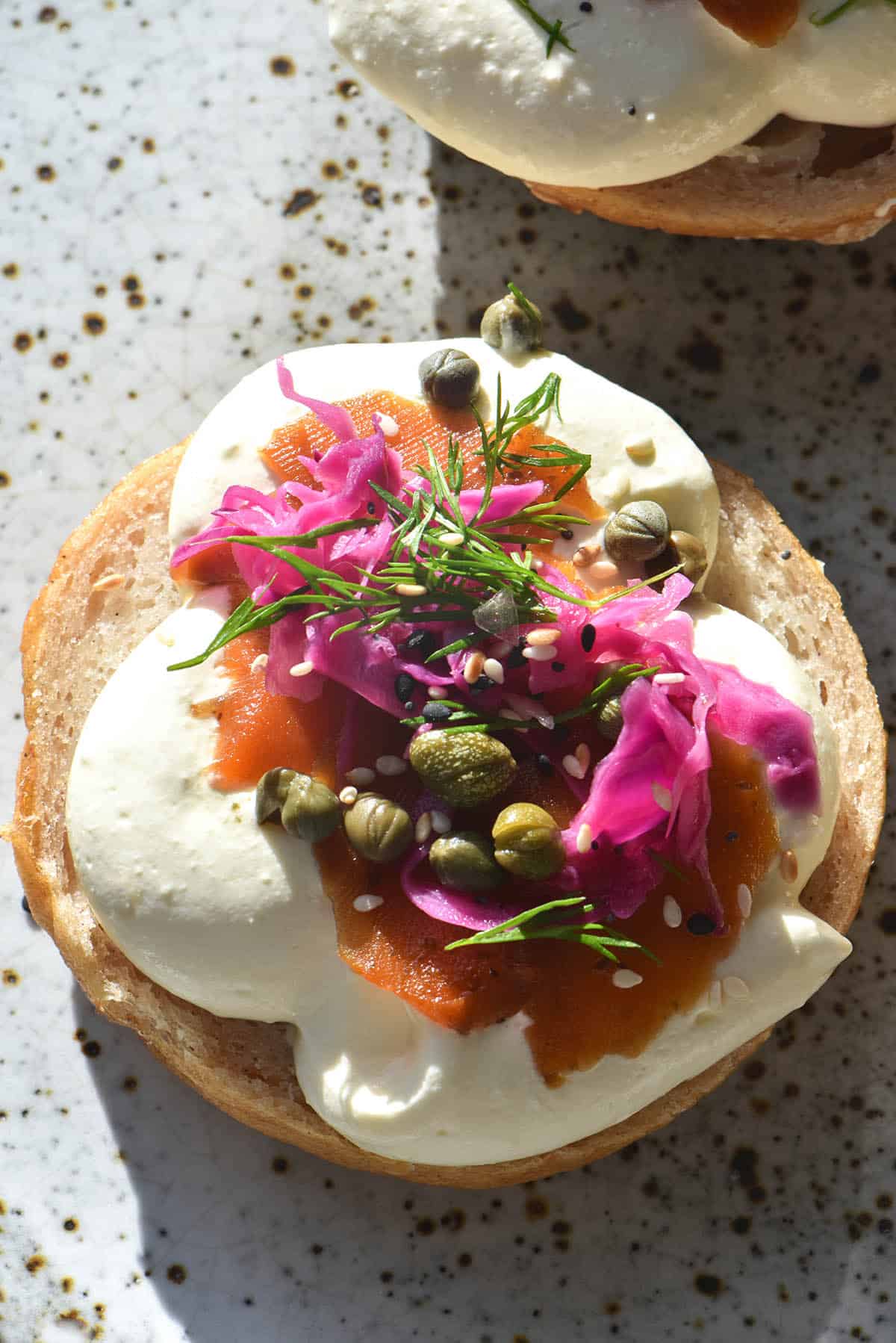
More troubleshooting
- If your bagels didn’t rise: check your yeast and boil them less next time. Boiling kills off some of the yeast and sets the outer crumb.
- For bagels that were too gummy: make sure you allow the crumb to cool and set completely before eating or slicing. A warm crumb has not set yet, and will likely present as gummy innards. Experiment with adding less water and a slightly longer cooking time. If the problem persists, try a higher ratio of wholegrain to starch or add a little less psyllium husk. Please note that I have not tried either of these options as I haven’t had this issue. This is simply what I would suggest if someone had this issue.
- If your bagels didn’t brown: Preheat your oven at a higher temperature and cook for a little longer. Did you add the salt and sugar? Make sure you do. If all else fails, try adding a pinch of baking soda to your boiling water. Make sure it’s a large pot though – if you are using an acidic ingredient to boil the bagels (like molasses) the baking soda will bubble up.

Flavour suggestions for the gluten free bagel dough
Just as you can flavour the top of your gluten free bagels with sesame seeds, everything bagel seasoning et al, so too can you flavour the innards. Some suggestions are:
- Chopped chives or spring onion greens (to keep them FODMAP friendly if they need to be)
- Cinnamon
- Raisins
Look, the list goes on. You can play around with a flavour you fancy – I’m not even close to a bagel expert. I prefer to keep it simple so that I can take the final toppings in any direction I like, but that might just be me.
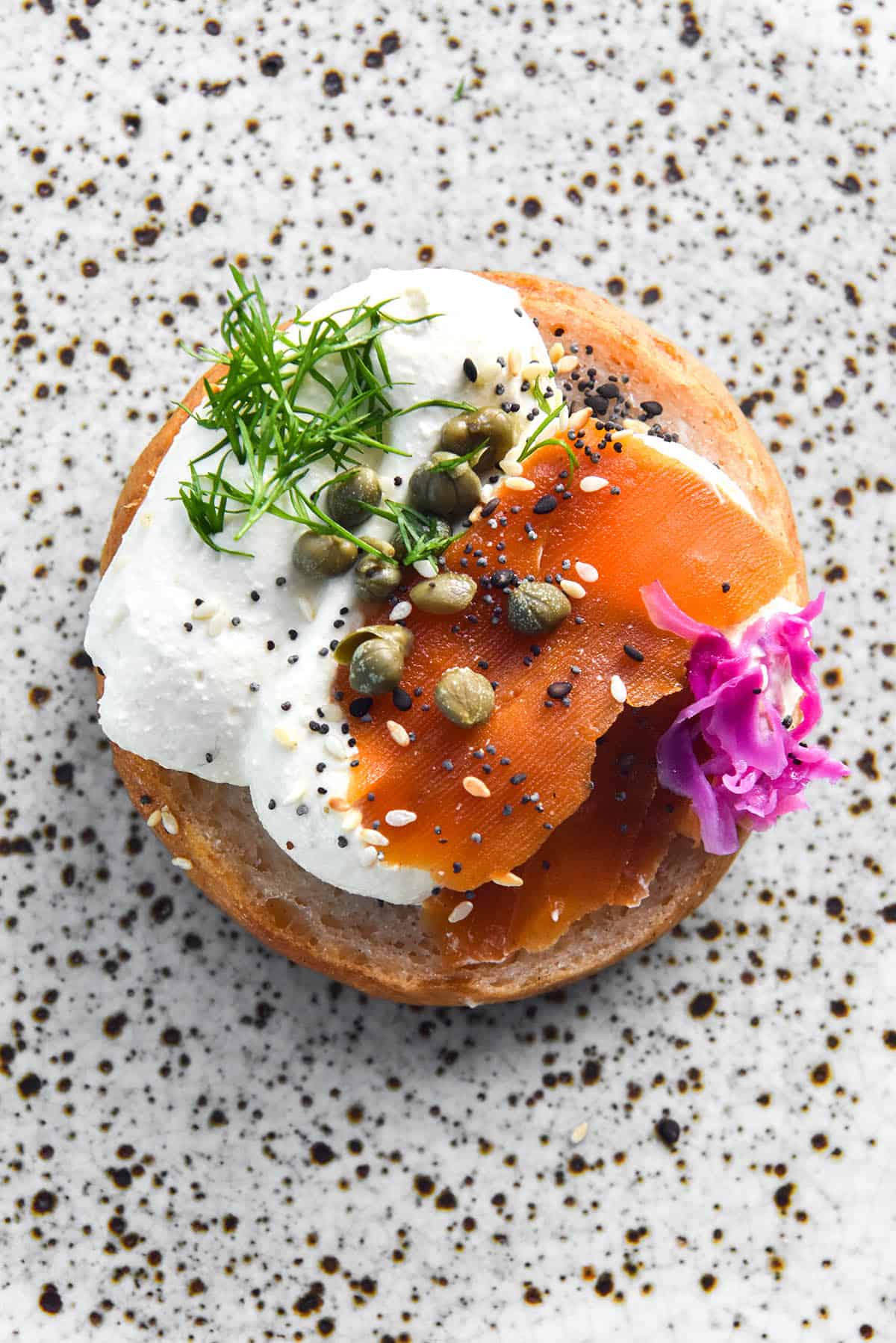
Topping suggestions
Again, you can top your bagels with whatever you like. The bagels in the photos were topped with:
- The FODMAP friendly everything bagel seasoning
- The lactose free mascarpone which I whipped with some leftover cream. I know, cream cheese is traditional, but inflation bites and I didn’t want to spend all that money when I had mascarpone in the fridge
- FODMAP friendly ‘pickled red onion’
- I finished these with carrot lox, capers and dill. I have a vegan carrot lox recipe here.
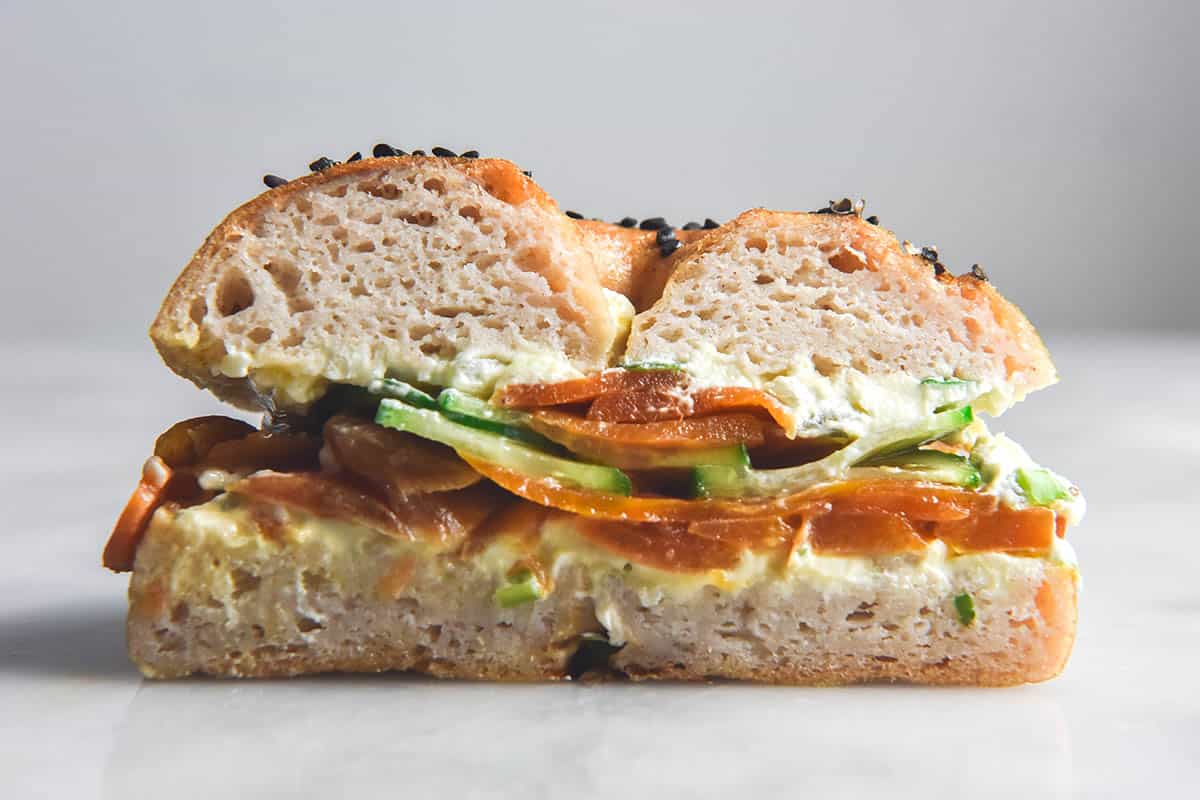
More gluten free bread recipes without xanthan gum
- These gluten free baguettes
- My favourite gluten free sourdough bread
- A white bread sourdough bread
- These gluten free bread rolls
- 100% buckwheat flour bagels from my buckwheat e-book
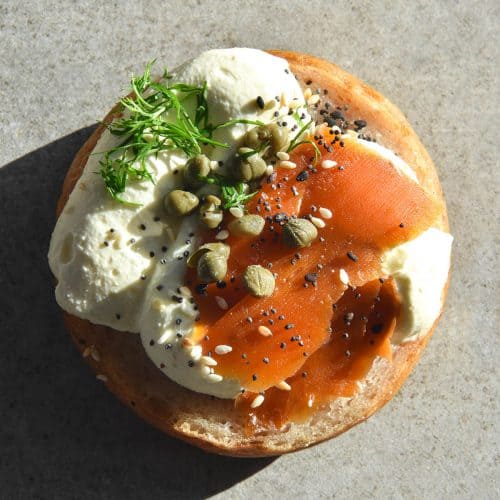
Gluten free bagels without xanthan gum (vegan option)
Ingredients
For the bagels:
- 220 g (1 1/2 cups) white rice flour
- 80 g (1/2 cup) sorghum flour
- 150-165 g boiling water
- 120 g (1 cup) tapioca flour
- 15 g psyllium husk powder
- 7.5 g (1 sachet) yeast
- 1 – 1 1/2 teaspoons fine salt (to your taste)
- 1/2 tablespoon sugar
- 1/4 cup (60ml) vegetable or plain oil
- 1 – 1 1/4 cups (250-310ml) warm water
To finish:
- 1 tablespoon molasses for water bath (you can use whatever sort of water bath you like)
- Salt
- Egg wash to wash the bagels (use a vegan alternative to keep these egg free/vegan)
- Everything bagel seasoning or your topping of choice see body of post or notes section for a link to a FODMAP friendly everything bagel recipe
Instructions
- Weigh the sorghum and rice flour in a medium sized mixing bowl and stir to combine. Measure 100g of that flour into another small bowl and set aside. This small bowl will form our scald.
- Pour 150-165g of boiling water evenly over the flour in the smaller bowl to make the scald. Have a whisk at the ready and vigorously whisk until a jelly like dough forms. It shouldn’t take more than 5-10 seconds. Set aside to cool a little.
- Add the tapioca flour, psyllium husk powder, yeast, salt and sugar to the larger, original bowl of flour. Whisk and set aside.
- Pour the contents of both bowls into your kitchen mixer with the paddle attachment.
- Process the dough on a low speed for 2-3 minutes until the scald has broken up completely in the dough. Drizzle in the oil, followed by the water, until a soft and pliable but not completely wet dough has formed. The higher hydration, the more open the crumb, but it can come at the expense of a gummy bagel. Add the water by sight and add the lesser amount if it’s your first time baking these bagels.
- Cover the dough and place into the fridge for 30 minutes to firm up and proof a little. Read the proofing notes section and choose the style of proofing you'd prefer. For the recipe card, we're assuming the bagels are not being proofed after shaping.
- While you wait, thoroughly preheat the oven. I like to preheat mine at 220C/430F to ensure it is at the right temperature for good oven spring.
- Fill a medium pot 3/4 of the way with water, and add the molasses and salt. Set it over a medium heat and bring to a boil.
- Take the dough out of the fridge and divide it into six or eight balls. Depending on how hydrated the dough is, you may need to lightly flour the bench (I use tapioca flour) or you may not.
- To form bagels, you can either roll out each piece of dough into a log and then brings the ends firmly together (use water on the ends to ensure they seal together) or you can form bagel sized disks of dough and use an oiled finger to create the bagel hole. Visually, I prefer the first option, but the second option is a bit easier and more foolproof.
- When the water has boiled, place each bagel into the water for 30-45 seconds. They don’t automatically float, so have a spatula on hand to very gently encourage it off the bottom if necessary. Place each bagel on a cake rack to drain the excess water while you boil the next one.
- Once you have boiled all the bagels, place them on a lined baking tray. Brush each bagel with egg wash or an alternative, and then sprinkle with your chosen topping. Place into the oven, adjust the heat to 200C/400F, then bake for 25-35 minutes or until golden, puffy and firm.
- If you are using a high hydration, wait until the crumb sets to eat one or else your bagel will be gummy. Leftovers keep really well for a number of days and can be frozen (I like to slice them prior to freezing).
Notes
- This recipe makes 6 large or 8 medium bagels.
- You can use cassava flour in place of tapioca flour for a starch free option. I found that they needed a little extra water.
- Here is the link for the FODMAP friendly everything bagel seasoning mix
- As always, the hydration is highly dependent on your flours. Brand to brand, country to country variation is huge, so you need to use your intuition.
- Add the boiling water to your scald by sight. If all your flour is hydrated and has formed a gel at 150g of water, you can use 150g. If you think you need a bit more, add 165g.
- Watch the main dough as you add the water. You should be able to pick the dough up in your hand (only just, if you use xanthan gum, because it gets sticky). The psyllium husk powder will absorb more liquid in the fridge, but the dough shouldn’t be a batter. You will get a sense for this in time if you make more bagels.
PROOFING OPTIONS
- Simply allow the dough to proof for 30 minutes in the fridge while it chills. It will continue to proof as you shape, boil and bake the bagels. This bagels will be the least fluffy inside.
- Allow the dough to proof for another 30 minutes in the fridge or on the bench after chilling.
- Shape the bagels, cover the surfaces with water (it helps stop cracking as the dough expands) and cover thoroughly (I use a floppy light plastic bag with a glass in the middle so it doesn’t touch them). Proof for one hour, then boil and bake. These bagels will be the most fluffy inside.

Leave a Reply